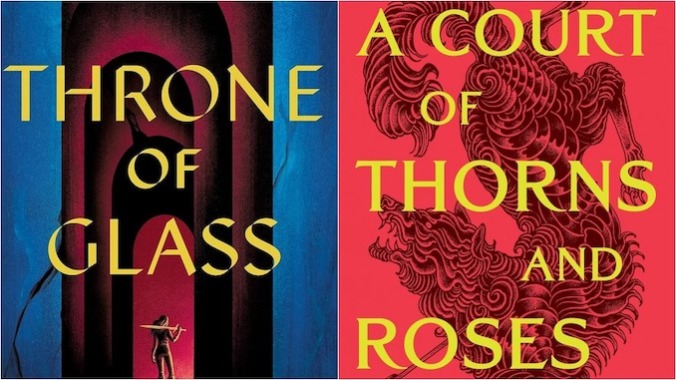Hear Me Out: Sarah J. Maas’s Throne of Glass Books Are Better Than ACOTAR
Subscriber Exclusive

Hear Me Out is a column dedicated to earnest reevaluations of those cast-off bits of pop-cultural ephemera that deserve a second look. Whether they’re films, TV series, albums, comedy specials, videogames or even cocktails, Hear Me Out is ready to go to bat for any underappreciated subject.

The story of a human woman taken away to the magical kingdom of Prythian after accidentally killing a fae in disguise, these 500+ page doorstoppers are full of hot faeries, political intrigue, soul bonds, and lots and lots of sex (some of which is not necessarily hindered by simple things like the rules of physics). Don’t get me wrong—the ACOTAR books are great. They’re incredibly addictive, featuring complex worldbuilding, a sprawling cast of interesting characters, and plenty of spice. But they’re not Maas’s best work. (There, I said it.) In fact, it’s well past time that the eight-part Throne of Glass series was given its proper due in our pop culture landscape. It’s amazing, and we should say so, often and loudly.
Though the ACOTAR books have undoubtedly launched Maas’s career into the stratosphere, Throne of Glass was her first series. And although it’s always been popular within fantasy spaces, it never quite reached the heights—or garnered the same level of mainstream visibility—that the books that would come after it did. The eponymous first novel was published in 2012 and followed the story of Celaena Sardothian, an 18-year-old assassin who attempts to win her freedom from a dangerous prison by entering a tournament where she must battle 23 other thieves, killers, and warriors. And while that may all sound like yet another The Hunger Games-style competition rip-off, it’s merely the tip of a much larger narrative iceberg that ultimately encompasses legacy, love, survival, freedom, self-discovery, and more. Its story spreads over seven books and a collection of prequel novellas, frequently doubling back on itself to reveal new information about the characters and events we thought we knew. Its multi-dimensional characters and the complex dynamics between them are endlessly satisfying and multiple compelling romances vie for readers’ hearts. And its sprawling, endlessly complex world—there’s a map in the front of these books for good reason—is fully realized down to the ground, composed of everything from shapeshifters, magic-wielders, faeries, and witches to warriors, healers, assassins, and more.
Unlike the ACOTAR series, Throne of Glass is a much more fantasy-forward kind of story. Although multiple romantic relationships are heavily featured and some of the later books have explicit sex scenes, this series is, as a whole, much more focused on the traditional tropes of high fantasy storytelling. There’s painful trauma, a necessary quest, a lost heir to a storied throne, and a larger battle for control of a kingdom. Clashing political interests, frequent betrayal, and complex relationships between the better part of a dozen characters give the sweeping story serious emotional heft, and the sprawling setting of Erilea is full of contrasting (and often competing) kingdoms and cultures. Though we may be most invested in Celaena’s journey, her story—both before and after she reclaims her identity as lost princess Aelin Ashryver Galathynius—-is impossible to separate from Erilea’s larger one, and the deft way it fits into the canvas’s larger historical and geopolitical narrative is impressively handled.
Compared to Feyre, the primary protagonist of A Court of Thorns and Roses, Aelin is a more complicated, difficult heroine, who can occasionally be hard to like. Courageous and intelligent, but also arrogant, stubborn, and occasionally cruel, she’s a character with many layers, for both good and ill. One of the more frequent complaints about Throne of Glass is that it reads much younger than ACOTAR, which is a fair comparison. After all, Maas herself was a teenager when she wrote the earliest books in this series, and they do lean more toward YA territory than those that follow afterward. But she and her heroine both grow and develop alongside one another, as a writer who discovers the power of her voice, and a heroine who finds the steel in her character. Aelin’s growth throughout this saga is genuinely astonishing and deeply satisfying to witness, and her character development is fully grounded in her own personal and emotional journey, rather than in any of her romantic relationships.
But what truly sets the Throne of Glass series apart is its deliberate, intricate, and often straight bonkers plotting. If you’ve noticed, this piece has relatively little in the way of story details, and that’s because it’s both incredibly difficult to describe all the complex twists and because it seems remarkably unfair to ruin the surprises for those who haven’t read this series yet. But trust me, if you think you know where this story’s going after reading Throne of Glass, or even its sequel, Crown of Midnight, I promise you really don’t. Maas repeatedly upends reader expectations throughout this series, revealing hidden identities, turning relationships on their heads, and recasting characters we thought were villains in a much more complex and morally gray light. Maas’s storytelling is exhilarating, emotional, and satisfying in a way that a lot of the ACOTAR books never really manage to equal—as much as I love many of the characters and romances in that series, Throne of Glass left me in tears more than once. (Whether those were tears of joy or sadness, I’ll leave it up to your own reading experience to determine.)
So do yourself a favor, ACOTAR fans. Give Maas’s first series a little bit of this same attention and obsession. Sure, they’re not quite as spicy as some of her later books, but once the story kicks into gear, you really won’t notice.
Lacy Baugher Milas is the Books Editor at Paste Magazine, but loves nerding out about all sorts of pop culture. You can find her on Twitter @LacyMB